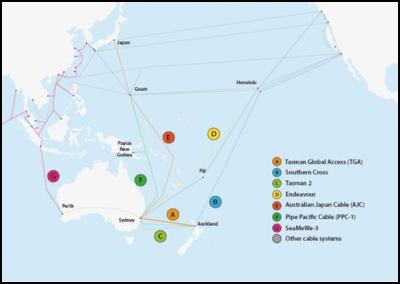USD $70 million submarine cable project underway in Raglan
17/03/2016
USD $70 million submarine cable project underway in Raglan

A team of specialist submarine
cable experts will arrive in Raglan this month to lay the
first section of the Tasman Global Access (TGA) undersea
cable.
Telecommunications companies Spark, Vodafone
and Telstra are investing approximately USD $70 million to
build the TGA cable, which will significantly improve New
Zealand’s international broadband
connectivity.
Other benefits of the new cable include
strengthened links into fast-growing Asian markets,
important redundancy and resiliency, and better connection
with the five main international cable systems currently
serving Australia.
The consortium of Spark, Vodafone
and Telstra have contracted Alcatel-Lucent Submarine
Networks (ASN), now part of Nokia, to lay the first cable
between Ngarunui Beach at Raglan and Narrabeen Beach in
Australia.
Spark’s General Manager Wholesale and
International, Lindsay Cowley, and Vodafone’s Wholesale
Director, Steve Rieger, jointly commented on behalf of the
consortium:
“The work in Raglan marks an exciting
and important milestone on the journey to having the TGA
cable ready to start carrying data across the Tasman towards
the end of 2016.
“The first stage will see the crew of the MV Tranquil Image - a specially fitted out New Zealand vessel - bury a three kilometre stretch of fibre optic cable from Ngarunui Beach, through the surf zone and into the ocean.
“Once the Raglan shore landing works are
complete, a larger specialised ASN ship will arrive in New
Zealand to connect the next section of cable, taking it
across the Tasman and eventually connecting it to the
Narrabeen Beach landing in Australia.”
The cable laying activities at Ngarunui Beach are scheduled to commence on 29 March and this first stage will take approximately one week to complete.
The consortium cautions that weather conditions may impact the schedule:
“The goal is to complete this first stage as quickly and seamlessly as possible, however the health and safety of the crew, and the public, are our first priority.
“We are keeping the Raglan community informed of the key construction dates and activities and we are extremely grateful for their understanding and support of the project so far,” said Lindsay Cowley and Steve Rieger.
The TGA cable is currently on track to be completed, tested and ready for service by the end of 2016. The 2,300km length of cable is comprised of two fibre pairs, and will have a total capacity of 20 terabits per second.
Further Raglan Landing site project details are as follows:
Constructor: Alcatel Submarine Networks
Project term: Start date for stage one at Raglan is from 29 March onwards, with a duration of approximately one week – subject to weather conditions. The start date for stage two – the cable lay across the Tasman to Narrabeen Beach in Australia, will follow on through a suitable marine window and will also be subject to weather conditions, ASN crew and equipment and ASN shipping scheduling of the main deep water marine works.
Notes to Editor:
• The Tasman Global Access (TGA) cable will meet future international bandwidth requirements for New Zealand consumers and businesses alike, which are set to grow by 11,000% in the next 10 years.
• The TGA landing at Raglan on our West Coast provides important cable route diversity to the existing Southern Cross cable connecting New Zealand to Australia and the USA.
• The TGA cable will enable New Zealand to better leverage the five main international cable systems currently serving Australia, and deliver important redundancy for New Zealand, as well as strengthening links into fast-growing Asian markets.
• Both Spark and Vodafone’s trans-Tasman internet traffic has grown from just 10 percent of total international traffic in 2000, to 40-50 percent today.
• With New Zealand’s international capacity requirements growing 60 percent year-on-year, (and projected 11,000% growth over 10 years) the TGA cable will support the future needs of consumers and the growth aspirations of New Zealand businesses.
• The TGA cable is a truly green project, in keeping with the ethos of Raglan. It will produce only short-term minor impacts on the environment that after one tide change will not be noticed, yet delivers limitless benefit for all of New Zealand in the long-term.
• In planning the TGA cable, particular care has been given to ensuring the work at Raglan has minimal impact. All major cable-laying work will be completed “off season” to minimise disruption to regular beach users. The consortium has taken advice from Raglan based marine ecologists regarding the cable route to shore. Local Iwi have also been consulted regarding their knowledge of the area and will continue to be involved in the development of the project.
ENDS


 Bill Bennett: Download Weekly - How would NZ telecoms cope with another cyclone
Bill Bennett: Download Weekly - How would NZ telecoms cope with another cyclone NZ On Air: Firm Audience Favourites Lead NZ On Air Non-Fiction Funding
NZ On Air: Firm Audience Favourites Lead NZ On Air Non-Fiction Funding Insurance and Financial Services Ombudsman: Woman Gets $40k More After Disputing Insurer’s Decision
Insurance and Financial Services Ombudsman: Woman Gets $40k More After Disputing Insurer’s Decision BNZ: A Quarter Of Older NZers Fear Going Online Due To Scam Concerns
BNZ: A Quarter Of Older NZers Fear Going Online Due To Scam Concerns University of Auckland: Scientists Develop Tool To Monitor Coastal Erosion In Fine Detail
University of Auckland: Scientists Develop Tool To Monitor Coastal Erosion In Fine Detail Oji Fibre Solutions: OjiFS Proposes To Discontinue Paper Production At Kinleith Mill
Oji Fibre Solutions: OjiFS Proposes To Discontinue Paper Production At Kinleith Mill



